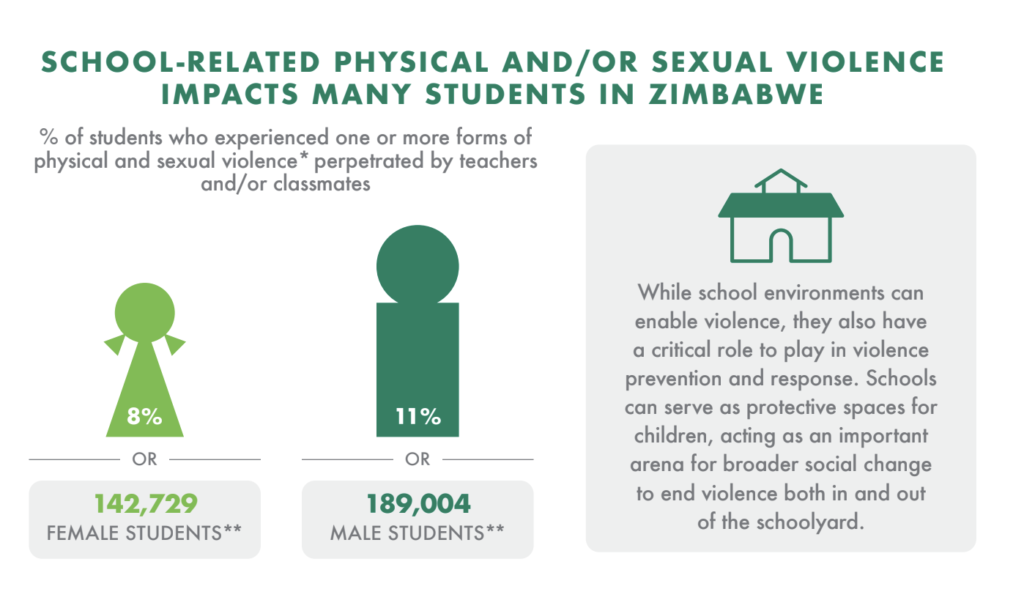When violence is ingrained in a child, it is difficult to reform that child into a nonviolent adult.
A violence-free future starts with cultivating the right attitudes in today’s children and youths.
Unfortunately, a lot of reports have been made about bullying at some schools in the country.
There is often a lot of fighting, rival gangs have in some cases become the order of the day.
In Bulawayo, for years police had to be deployed on closing days to curb turf wars at some notorious schools. This applies to both male and female learners.
School-Related Gender-Based Violence (SRGBV) is any act or threat of sexual, physical or psychological violence occurring in and around schools, perpetrated as a result of gender norms and stereotypes, and enforced by unequal power dynamics.
SRGBV violates children’s fundamental rights, is a form of gender discrimination, and has wide-ranging consequences for children’s physical and emotional well-being, school performance and attendance and likelihood of experiencing or perpetrating future violence.
The Zimbabwe 2021 Violence against children reports shows that 8 percent of girls and 11 percent of boys experienced at least one form of violence perpetrated by teachers and classmates within the school system.

Male students have reported more physical violence acts from their teachers as compared to girls.
In Zimbabwe, both girls and boys experience high rates of physical, sexual, and emotional violence.
Violence can occur in the home, community, and at school. The VACS are nationally representative household surveys of children and young adults aged 13 to 24 years that measure the prevalence and circumstances surrounding emotional, physical, and sexual violence against males and females in childhood, adolescence, and young adulthood.
The report helps identify the prevalence of school-related gender-based violence, as well as details on violence perpetration, victimization risk, and post-violence behaviors for girls and boys in Zimbabwe.
According to the report, 17 percent of girls and 23 percent of boys experience physical, violence prior to age 18. Nine percent of girls and 1 percent of boys experience sexual violence before they reach adulthood, while 10 percent of girls and 6 percent of boys experience emotional violence before they turn 18.
Most interventions on Gender-Based Violence are often targeted at adults. However, for better and violence-free communities, efforts should be made to ensure that the relevant programming that seeks to eliminate all forms of violence is crafted and properly packaged for children.
While school environments can enable violence, they also have a critical role to play in violence prevention and response. Schools can serve as protective spaces for children, acting as an important arena for broader social change to end violence both in and out of the schoolyard.
Every child deserves to be safe in school. However, research shows that across the globe students experience high rates of school-related physical, sexual and psychological violence.
This can include teacher-perpetrated abuse, such as corporal punishment or sexual coercion. It can also include peer-perpetrated abuse, like bullying or discrimination. While school environments can enable violence, they also have a critical role to play in violence prevention and response.
Schools can serve as protective spaces for children, acting as an important arena for broader social change to end violence both in and out of the classroom.
Some reports of school-related violence can be terrifying. Where is all the violence coming from, one may ask? For all acts of violence, there is often a trigger. Some acts of violence are a result of the upbringing that some young people may have received. Some children come from very violent homes, and sometimes, it can be seen from the manner in which they behave, some children may be victims of abuse, and the violent nature that they exhibit could be communicating something about their brokenness.
Some students who experience such traumatizing forms of violence end up missing school for days or weeks, while others eventually drop out, or adopt violent behaviours as a coping mechanism.
It is important to intervene in such situations in order to make young people understand that violence is not the answer and that any disagreements that are solved by violent means rarely ever end well.
According to United Nations Educational, Scientific and Cultural Organization, school-related gender-based violence (SRGBV) affects millions of children, families and communities globally. It involves acts or threats of sexual, physical or psychological violence occurring in and around schools, perpetrated because of gender norms and stereotypes, and enforced by unequal power dynamics.
SRGBV has very real consequences in learners’ lives, ranging from low self-esteem and depression to early and unintended pregnancy and sexually transmitted infections such as HIV. This violence also has a serious impact on educational outcomes, with many students avoiding school, achieving below their potential, or dropping out completely.
In every country and region of the world where SRGBV has been studied, incidents have been reported.
While SRGBV is aggravated in countries affected by conflict, it is otherwise pervasive, cutting across cultural, geographic and economic barriers. Cases have been reported in booth urban, rural, public and private schools.









